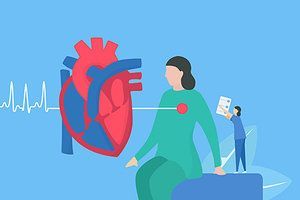Some doctors thrive in a personality-based clinic and have a loyal following no matter what services or equipment they offer, but for most chiropractic offices who are trying to grow and expand, new equipment purchases help us stay relevant and continue to service our client base in the best, most up-to-date manner possible. So, regarding equipment purchasing: should you lease, get a bank loan, or pay cash?
How Did I Miss This? The Heart of the Matter
Let's discuss a putative, evidence-based case of a female patient presenting with complaints of neck and upper back pain. I aspire to challenge your differential diagnosis skills and augment your clinical skills. Four questions challenge you and enhance your learning opportunity, as the purpose of this column is to continually improve your quality of care.
Subjective / History
A female, 60 years of age, presents with a chief concern of,"My neck and back are killing me." The daily, aching pain in the neck and upper back started three months ago. For the past two days, the pain has become a more severe, stabbing pain in the upper thoracic spine. She claims it feels like a dagger going back and forth across her upper back. There is no history of trauma, or previous cervical or thoracic pain.
She rates the aching pain at 3-4/10 while performing work on the computer. The pain reduces to 0-2/10 with rest and a glass of wine. Currently, the sharp, stabbing pain in the upper back is 10/10. She thinks chiropractic care might reduce the pain because she responded well to previous chiropractic care for her LBP problems. There is no radiating or referred pain into the extremities.

For the past month, she has not been sleeping well and feels tired. She has been under a great deal of stress because her elderly parents were diagnosed with COVID-19. They are in a senior living facility and she unable to visit them. The aching pain in the neck and upper back did start after her parents moved from their home to the senior facility.
She thinks all of her problems (pain) are related to the increased stress of caring for her parents over the past three years and the recent change in their residence.
Family history: Both parents alive. Mother 80 years of age and treated for diabetes. Father is 84 years of age with a history of heart failure, stage three. She has no siblings.
Past history: No surgeries or significant diseases. She has been diagnosed with anxiety. She is not very active and denies any regular physical exercise.
Objective Evaluation / Findings
The patient presents as a polite woman appearing her stated age. She is a good historian. It is obvious she is very uncomfortable because of the cervical and dorsal pains.
Vital signs: B/P 106/ 50, pulse rate 52 per minute, oral temperature 99.06 F and respirations 10 per minute.
Posture / Gait: Forward head posture with rounding of the shoulders is present. Pelvic obliquity is present with functional leg-length inequality of the left lower extremity. Gait appears normal without loss of balance, pain or limping.
Palpation: Tenderness is elicited with palpation of the paravertebral muscles bilaterally in the cervical and upper thoracic spine. Palpation of the midline of the cervical spine produces ligamentum nuchae tenderness at the level of C4-6. None of the palpation reproduces the patient's chief concern pain.
Active ROM: Cervical ROM demonstrates reduced global range of motion in all six cardinal ranges without pain. Resistive and passive ranges of motion are without pain. Active thoracolumbar and lumbosacral range of motion full and symmetrical without pain. Cervical compression tests negative for pain.
Neurological exam: Negative for loss of balance, memory loss or confusion. DTR 2+ and symmetric for upper and lower extremities. Sensory intact for pain and light touch for upper and lower extremities without signs of hypesthesia or hyperpathia. Motor intact and 5/5 for upper and lower extremities. Pathological reflexes absent for upper and lower extremities.
My Assessment
- Chronic pain syndrome without trauma (G89.4)
- Myofascial pain syndrome
- Symptoms complicated by anxiety and distress
Treatment Plan
- Soft-tissue treatment daily for three days to relieve pain
- Recommended counseling with a behavioral health specialist to address anxiety and distress
- Seek a trainer to create an exercise routine to increase strength and activity level
Outcome: What Went Wrong?
Unfortunately, the patient expired during her sleep the following morning after the initial visit because of a myocardial infarct. What did I miss?
I teach that the importance of orthopedic testing is normally the reproduction of the chief concern pain in order to identify the pain-generating tissues. Hence, I offer the following definition of an orthopedic test: An orthopedic test is most often (but not always) a provocative maneuver that reproduces the patient's chief concern pain with stretching, contracting and/or compression in order to identify the involved tissues.
If you perform orthopedic testing and do not reproduce the chief concern, you have not identified a neuromusculoskeletal condition as the cause of the patient's chief concern pain, and additional evaluation is warranted by you or another provider.
Questions to Be Answered
- I reproduced the chief concern pain with provocative orthopedic testing. True or False?
- I recognized the change in severity of the thoracic pain without trauma as a possible sign of a myocardial infarct. True or False
- Women are significantly less likely to report chest pain or discomfort compared with men. True or False?
- Is it well-recognized that myocardial infarct (MI) may occur without any symptoms (silent); or that MI may occur without "typical" chest pain
or discomfort and thus go unrecognized by patients or their physicians.
True or False?
Signs of SMI
Silent myocardial infarct (SMI) symptoms are often mild and brief. You / your patient should seek immediate medical attention if you or your patient experiences one or more of the following:
- Discomfort in the center of the chest that lasts several minutes, or goes away and comes back; it can feel like an uncomfortable pressure, squeezing or pain
- Discomfort in other upper-body areas, such as one or both arms, the back, the neck, the jaw, or the stomach
- Shortness of breath before or during chest discomfort
- Breaking out in a cold sweat, or feeling nauseated or lightheaded
Quiz Answers: 1. False 2. False 3. True 4. True
Resources
- "The Danger of Silent Heart Attacks." Harvard Health Publishing; last updated Nov. 3, 2020.
- Canto JG, et al. Symptom presentation of women with acute coronary symptoms: myth vs. reality. (review) Arch Int Med, 2007;167(22):2405-2413.
- O'Keefe McCarthy S. Women's experiences of cardiac pain: a review of the literature. Can J Cardiovasc Nurs, 2008;18(3):18-25.
- Berg J, et al. Symptoms of first myocardial infarction in men and women. Gend Med, 2009 Sep;6(3):454-62.



